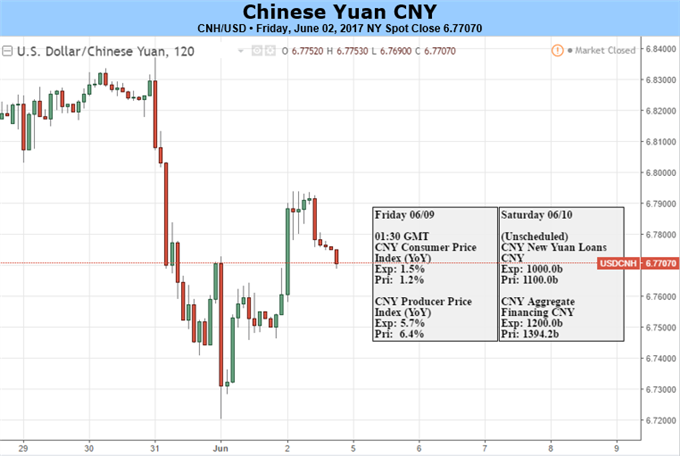

Fundamental Forecast for CNH: Neutral
The USD/CNH broke Yuan Soared to 7-Month High – What’s Next? (resistance for the Yuan) this week, amid tightened Yuan liquidity in the offshore market. HIBOR O/N, Yuan’s borrowing cost in Hong Kong’s interbank market, soared to 42.8% on June 1st, the highest level since January. On Friday, the tightened condition was eased, with HIBOR O/N falling to 8.7%; yet, this is still considerable higher than 3.4%, the average rate over the past 12 months. Next week, Yuan’s funding cost, PBOC’s guidance as well as a heavy Chinese economic calendar will all weigh on Yuan rates.
A sudden elevated Yuan’s borrowing cost can help to squeeze out Yuan shorts as it becomes more expensive for traders to sell the currency; the USD/CNH dipped 6.7205 on Thursday amid a 5-month high HIBOR. However, this does not mean the Yuan can hold at such strong level for long; Yuan’s strength driven by unusually high borrowing costs could fade quickly when HIBOR drops and returns to its normal range.
Also, note that Yuan’s reference rate, set by the PBOC, maintained above 6.80, despite that the Yuan jumped against the U.S. Dollar in the offshore market. On Friday, after the funding cost for the Yuan began to drop, the offshore pair moved towards the guided level. As of 4:30 pm ET, the offshore Yuan is about 300 pips away from the Yuan fix. Next week, PBOC’s reference rate will continue to be a key indicator that can largely impact the next trend of the USD/CNH.
Event risk from home is likely to motivate waves in Yuan rates as well. China will release exports and imports prints for May next week, both of which are expected to expand at a slower rate according to Bloomberg. China’s Premier Li Keqiang visited Europe this week and met with German Chancellor Merkel and EU leaders, sending out a signal that China would like to promote free trade and investment. As the U.S. becomes less engaged, China is shifting to strengthen ties with other partners; China’s One-Belt, One-Road initiative serves this purpose. Yet, there are still tasks to work on: during the EU-China summit, the two parties have not reached a final deal on China’s steel overcapacity issue despite that “differences are narrowed”.
















